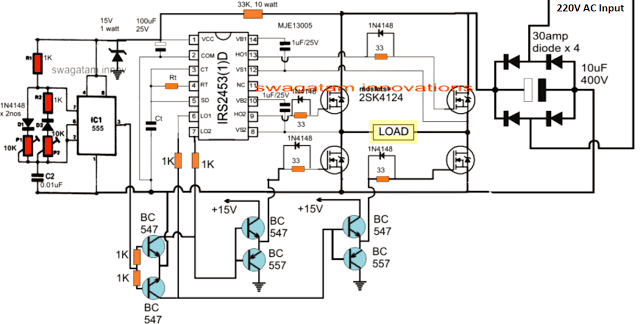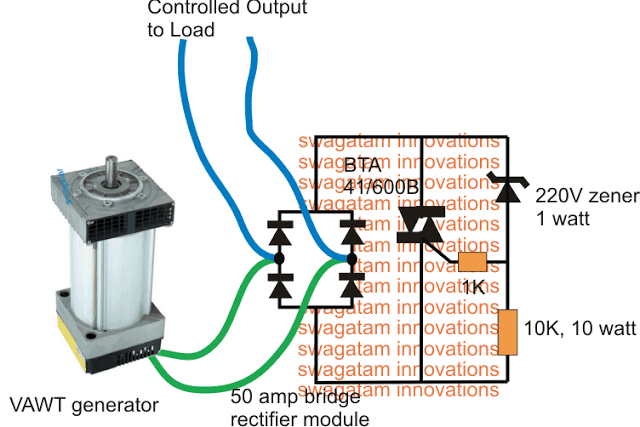In this post I have explained a diesel generator RPM controller circuit for boats using PWM technique and also using a simple triac shunt circuit. The idea was requested by Mr. Dave.
Circuit Objectives and Requirements
- I have been looking with interest at your electronic circuits web site and would appreciate it you could comment on the following
- I presently run a 220v 50 hz generator from the main diesel engine in my boat, the RPM of this engine is NOT governed and is difficult to set at the correct rev to keep the generator at the correct RPM for 50 hz output
- Would it be possible to convert this varying AC FREQUENCY 220V to 220v dc using a bridge rectifier and then convert it back to 220 v olts 50hz
- This would solve a major problem for those of us that have small boats that do not have space or are able to carry the extra load of another marine diesel engine, the generator is capable of 4kva output
- Your comments would be appreciated
The Design
The requested circuit deign for controlling a diesel generator RPM can be executed either by employing a PWM technique or the same could be implemented through an automatic shunt regulator circuit design, I have explained the two counterparts from the following explanation:

The first idea as indicated above employs an IRS2453 full bridge inverter circuit and an attached IC 555 PWM controller stage for the intended RPM control of a diesel generator output.
The design looks pretty straightforward, wherein the diode bridge network converts the 220V input to a 330V DC bus voltage for the full bridge driver network, which in turn converts it into a 220V AC square wave through the associated 4 N-channel push pull mosfet network.
Since this output is 330V DC square wave output, it is appropriately processed using the IC 555 PWM section into the required 220V AC sine wave output.The PWM setting ensures a fixed 220V output which can e expected to be relatively stble without fluctuations.
Using the Triac Shunt Method
Although precise, the above concept looks quite elaborate and complex when compared to the following simple triac shunt based diesel generator controller circuit:
The above circuit was originally designed for controlling a windmill VAWT motor
However the same design could be also effectively used for controlling a diesel generator output to a fixed 220V.
The circuit looks much simpler and self explanatory.
The bridge rectifier converts both the half cycles from the diesel generator into positive full wave cycles for the triac, so that the triac circuit is able to shunt both these cycles to ground that may exceed the 220V mark.
The 220v zener diode fixes the shunting level for the triac, this section could be replaced using TL431 shunt zener IC for enabling an accurate temperature stabilized output for the generator.The bridge network must be adequately rated to handle the generator current peaks.

What are ct and rt values?
You will have fix them practically using a frequency meter.
thanks
What is the role of MJE13005 in the schematic, please?
Please ignore it….it is mistakenly shown there.
Very good plan. thank you.
what is the acceptable range for +15vdc?
thanks
Is +12vdc ok?
Yes, 12V can be used for operating the driver section.
the simplest way to convert generator’s AC to stabilize voltage with exactly=50Hz it to buy a VFD-vario frequency drive or of any another similar product from any another country.
Single phase generator’s power will be given to A and B input-phases of the VFD with a loads – to exit of the VFD. Than – to program the VFD properly=according to the user’s needs – the programming can be behind of usual application’s but within of physical possibilities of the VFD. Details of the programming depends on the VFD model.
what is the “load” in the h bridge configuration
any electrical appliance
Good morning, excellent material that I find on the site, I congratulate you
Please I would like to know more about IGBT, if possible more content with control circuits and practical applications, such as sine wave inverters
Thank you
Glad you liked it! Using IGBTs is not complex. You can apply any voltage between 2 to 12V to switch them ON, while the load must be within the rated limits or the specifications of the device.
The base does not require a resistor unlike BJTs since IGBTs have high niput impedance, like MOSFeTs
Ok muchas gracias, y estoy atento a nuevas publicaciones
Above comment for three phase inverter
please post your question under the 3 phase inverter article
I’m give the output of LM 324 to mosfet which drive the led.but not drive the transformer for voltage up
Sir. What I do
sorry, I could not understand your question, which circuit are you referring to?
nice